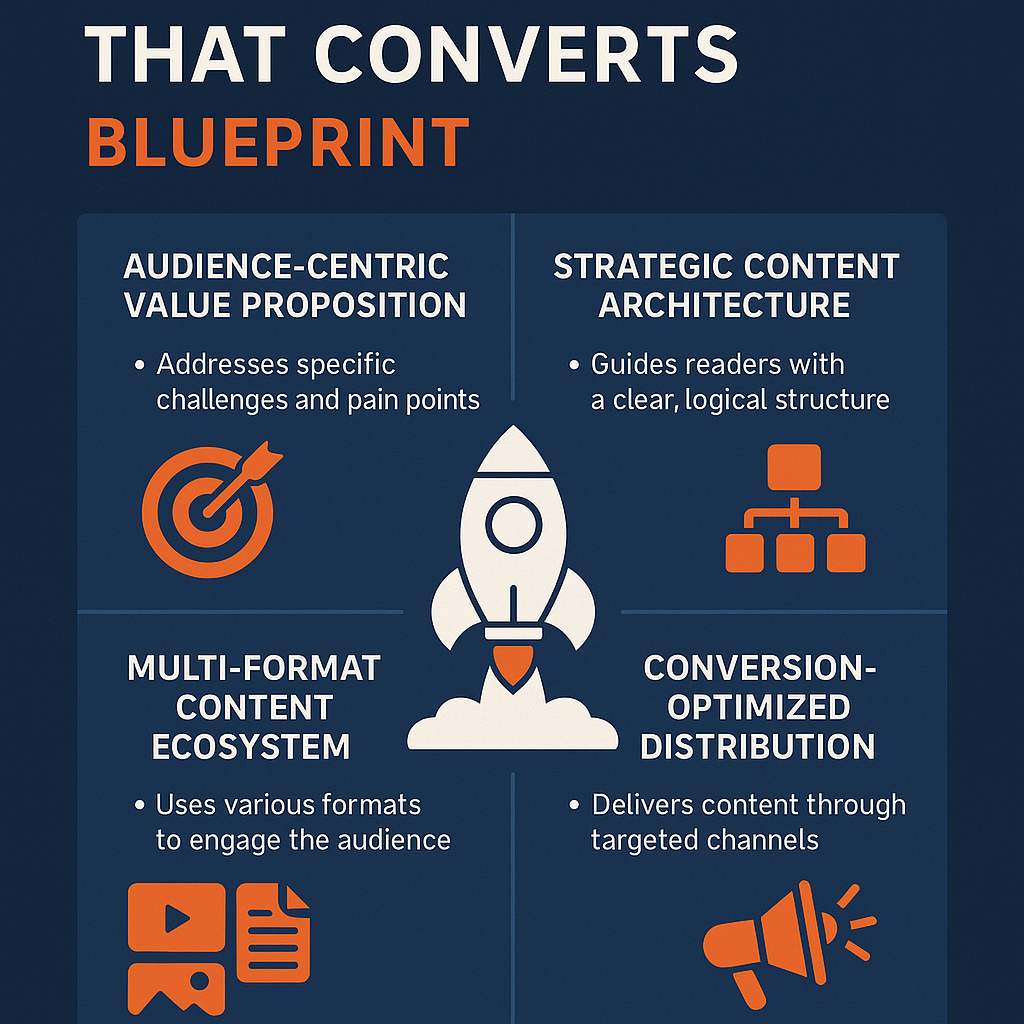In the crowded landscape of B2B marketing, content is everywhere. LinkedIn feeds overflow with thought leadership pieces, email inboxes burst with newsletters, and company blogs publish dozens of articles weekly. Yet despite this content explosion, most B2B marketers struggle with a fundamental challenge: creating content that actually converts.
The harsh reality? Less than 30% of B2B content generates meaningful engagement, and even fewer pieces drive qualified leads through the funnel. This disconnect between content volume and content conversion rates represents one of the biggest opportunities—and frustrations—in modern B2B marketing.
As a content strategist who’s analyzed thousands of B2B campaigns, I’ve seen the patterns that separate high-performing content from the digital noise. The difference isn’t just about clever headlines or polished design. It’s about understanding the fundamental anatomy of conversion-focused content and implementing a systematic approach to B2B content creation.

Understanding the B2B Content Conversion Challenge
Before diving into solutions, let’s address the elephant in the room: why is B2B content conversion so difficult?
Unlike B2C purchases driven by emotion and impulse, B2B decisions involve multiple stakeholders, longer sales cycles, and higher stakes. Your content isn’t just competing for attention—it’s competing for trust, credibility, and ultimately, budget allocation. This complexity demands a more sophisticated approach to lead generation content that goes beyond surface-level engagement metrics.
The most successful B2B content marketers understand that conversion isn’t a single moment but a process. Each piece of content serves as a stepping stone in a longer journey, building trust and demonstrating expertise while guiding prospects toward meaningful action.
The Four Pillars of High-Converting B2B Content
Pillar 1: Audience-Centric Value Proposition
High-converting B2B content starts with a crystal-clear understanding of your audience’s specific challenges, goals, and decision-making process. This goes beyond basic buyer personas to include situational context, timing considerations, and the political dynamics within their organizations.
Effective B2B content creation begins with these essential questions: What keeps your audience awake at 2 AM? What metrics do they need to improve to get promoted? What obstacles prevent them from achieving their goals? The answers to these questions become the foundation for content that resonates at a deeper level.
Consider how Salesforce approaches this principle. Their content doesn’t just discuss CRM features—it addresses the specific pain points of sales managers struggling to forecast accurately or marketing directors trying to prove ROI. This audience-centric approach transforms generic product content into compelling narratives that speak directly to reader challenges.
The key is specificity. Instead of creating content about “improving sales performance,” focus on “reducing sales cycle length for enterprise software deals in competitive markets.” This precision helps your content cut through the noise and connect with the right audience at the right moment.
Pillar 2: Strategic Content Architecture
Converting B2B content follows a deliberate structure that guides readers from initial interest to specific action. This architecture consists of five critical components: the hook, credibility markers, value delivery, proof elements, and clear next steps.
The hook captures attention by addressing a specific problem or opportunity. Unlike clickbait headlines, effective B2B hooks set accurate expectations while creating urgency around the reader’s current situation. Think “Why 67% of B2B sales teams miss quota (and how to fix it)” rather than “This one trick will revolutionize your sales process.”
Credibility markers establish your authority early in the content. These might include relevant experience, specific data points, or partnerships with recognized industry leaders. The goal is to answer the reader’s implicit question: “Why should I trust you with my time and attention?”
Value delivery forms the content’s core. This isn’t just information sharing—it’s providing actionable insights that readers can implement immediately. The best B2B content offers a mix of strategic thinking and tactical guidance, giving readers both the “why” and the “how.”
Proof elements validate your claims through case studies, testimonials, or concrete results. In B2B marketing, social proof carries enormous weight because decision-makers need to justify their choices to colleagues and supervisors.
Finally, clear next steps remove friction from the conversion process. Whether that’s downloading a resource, scheduling a demo, or joining a webinar, the path forward should be obvious and valuable.
Pillar 3: Multi-Format Content Ecosystem
High-performing B2B content rarely exists in isolation. Instead, it’s part of an interconnected ecosystem where different formats serve different purposes in the buyer’s journey. This approach maximizes content conversion rates by meeting prospects where they are and in the format they prefer.
Blog posts excel at addressing specific questions and establishing thought leadership. They’re perfect for capturing organic search traffic and nurturing existing subscribers. However, they’re just the beginning of the content journey.
Whitepapers and research reports work exceptionally well for lead generation content because they offer substantial value in exchange for contact information. The key is ensuring the gated content provides insights that aren’t available elsewhere.
Video content has become increasingly important in B2B marketing, particularly for complex topics that benefit from visual explanation. Product demos, expert interviews, and educational webinars can significantly boost engagement and conversion rates.
Interactive content like assessments, calculators, and diagnostic tools create highly engaging experiences while collecting valuable prospect data. These formats often generate the highest conversion rates because they provide personalized value.
The most successful B2B marketers create content clusters around core topics, with each format serving a specific purpose in the conversion funnel. A single topic might spawn a blog post for awareness, a webinar for consideration, a case study for evaluation, and a free trial for decision-making.
Pillar 4: Conversion-Optimized Distribution
Creating exceptional content is only half the battle. The other half is ensuring it reaches the right audience through the right channels at the right time. This requires a strategic approach to content distribution that goes far beyond “post and pray” tactics.
Email marketing remains one of the most effective channels for B2B content distribution, but success requires segmentation and personalization. Different audience segments need different content at different stages of their journey. A prospect who just discovered your company needs different content than someone who’s been evaluating solutions for three months.
LinkedIn has become the dominant platform for B2B content distribution, but effective LinkedIn marketing requires understanding the platform’s unique dynamics. Content that performs well on LinkedIn tends to be more personal, conversation-starting, and community-focused rather than purely promotional.
Search engine optimization plays a crucial role in long-term content success. High-converting B2B content should target specific keywords that align with buyer intent, not just search volume. Someone searching for “enterprise CRM comparison” is much closer to a purchase decision than someone searching for “what is CRM.”
Paid promotion can accelerate content performance, but it requires careful targeting and measurement. The goal isn’t just traffic—it’s qualified traffic that’s likely to convert. This means focusing on specific job titles, company sizes, and behavioral indicators rather than broad demographic targeting.
Measuring and Optimizing Content Performance
The most successful B2B content marketers obsess over metrics that matter. While vanity metrics like page views and social shares provide some insight, conversion-focused metrics tell the real story of content performance.
Lead quality metrics deserve particular attention. Not all leads are created equal, and high-converting content should generate leads that are more likely to become customers. Track metrics like lead-to-opportunity conversion rates, sales qualification rates, and average deal size by content source.
Content engagement depth provides insight into how well your content resonates with the target audience. Metrics like time on page, scroll depth, and return visitor rates indicate whether your content delivers genuine value or just attracts curiosity.
Attribution analysis helps you understand how different content pieces contribute to the overall conversion process. In B2B marketing, prospects typically engage with multiple content pieces before converting, so understanding these interaction patterns is crucial for optimization.
A/B testing should be an ongoing practice, not a one-time activity. Test different headlines, content formats, calls-to-action, and distribution strategies to continuously improve performance. Small improvements compound over time to create significant gains in content conversion rates.
The Future of B2B Content Conversion
The B2B content landscape continues evolving rapidly. Artificial intelligence is changing how content gets created and distributed, while privacy regulations are affecting how we track and measure performance. Buyer expectations continue rising as content quality improves across the industry.
However, the fundamental principles of high-converting B2B content remain constant: deep audience understanding, strategic value delivery, multi-format ecosystems, and optimized distribution. Companies that master these fundamentals while adapting to new technologies and platforms will continue to see strong results from their content marketing investments.
The opportunity for B2B marketers has never been greater. As the digital noise increases, truly valuable, conversion-focused content becomes even more precious. By following the principles outlined in this blueprint and committing to continuous improvement, you can create B2B content that not only captures attention but drives meaningful business results.
Remember, high-converting B2B content isn’t about perfection—it’s about connection. Focus on serving your audience’s needs, measure what matters, and iterate based on results. The companies that consistently create content their audience genuinely values will always outperform those that prioritize volume over quality.
Your content strategy should be a competitive advantage, not just a marketing activity. Make it count.
